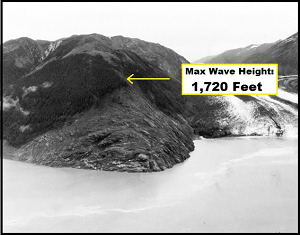
Flooding and landslides cause deaths, injuries, and homelessness every year, and damage or destroy buildings, roads, and other infrastructure. Studies show that changing climatic conditions, resulting in increased rainfall, permafrost degradation, and melting sea and glacier ice, can increase the frequency of fast-moving, catastrophic landslides and flooding events. Greater storm intensity enhances flooding and erosion in coastal environments and can lead to larger and more frequent landslides inland.
Almost nine out of every ten Alaska Native villages experience flooding and/or erosion. Floods in Alaska commonly result from coastal storm surge, ice jams in rivers, high precipitation events, or rapid thawing of winter snow and ice.
Coastal floods are caused when storms move across the ocean and push water up onto the beach, which is called storm surge. Wave runup and fluctuations in the tide cycle can cause even more flooding. Winter storms and less sea ice during fall lead to more erosion and flooding. DGGS works with communities and other partners to collect accurate coastal elevation data, nearshore bathymetry, and water levels critical for modeling floods and making informed decisions about the coastal zone.

Riverine floods are very common in Alaska and can cause severe erosion along riverbanks. Many springtime floods are generated by ice jams on major rivers when there is a back-up of water into surrounding areas because a river or stream is blocked by a buildup of ice or other debris (for example, 2013 Yukon River flooding near Galena). Aufeis can cause flooding too; it is a form of ice that builds during the winter on streams and rivers when ground water is forced by hydraulic pressure to break through to the surface and flow on top of previously-formed ice. Aufeis can sometimes cause streams and rivers to jump out of their traditional flood plain, causing floods in unexpected areas (for example, 2015 Dalton Highway flooding).

Lituya Bay Landslide. On July 9, 1958, a magnitude 8 earthquake along the Fairweather Fault dislodged about 40 million cubic yards of rock from a mountainside, sending it 3,000 feet downslope into Gilbert Inlet. The wave that followed surged 1,720 feet up a mountain slope and left vegetation trim-lines along the bay that are still visible today. Photo credit: U.S. Geological Survey.
Landslide is a catch-all term that refers to mass movement of rock and soil on slopes that have become too steep to be stable. Stable slopes can become unstable with added groundwater pressure, which is why landslides often happen during or after heavy rainfall. Alaska's climate and geology sets the landscape up for landslides. Alaska has trigger mechanismsms, such as permafrost degradation, glacial retreat, earthquakes, and isostatic rebound (uplift of the Earth's crust after a heavy weight is removed). These trigger mechanisms can cause some unique types of landslides such as snow-ice-rock avalanches and frozen debris flows. Collapse of hanging glaciers and rock-ice faces is most common in areas with glaciers and steep topography—frequently the same areas that attract tourists. These types of landslides are among the most dangerous to people and infrastructure.
Alaska's warming climate has already caused many areas to become unstable. Future warming will increase landslide risk throughout the state, especially in permafrost and glacial regions. At the same time, population growth and the expansion of settlements and lifelines over potentially hazardous areas increases the impact of landslides.
Landslide maps help raise awareness and promote public safety. Unfortunately, very few landslide maps exist for Alaska. Investments in landslide research and maps are needed to help provide up-to-date awareness of areas of instability before problems occur and can save time, money, and lives.